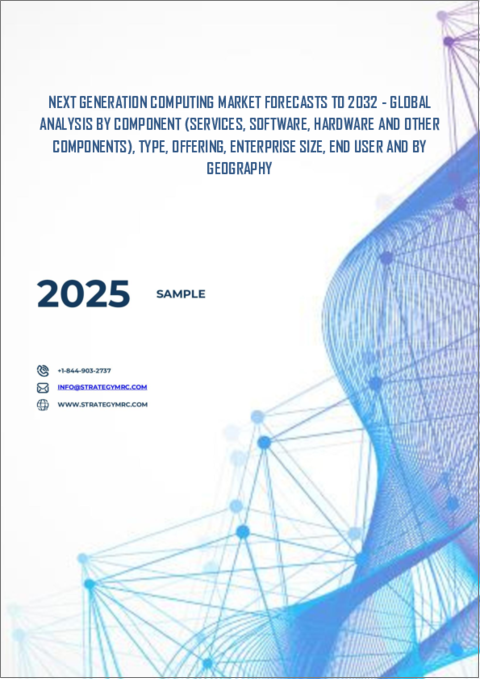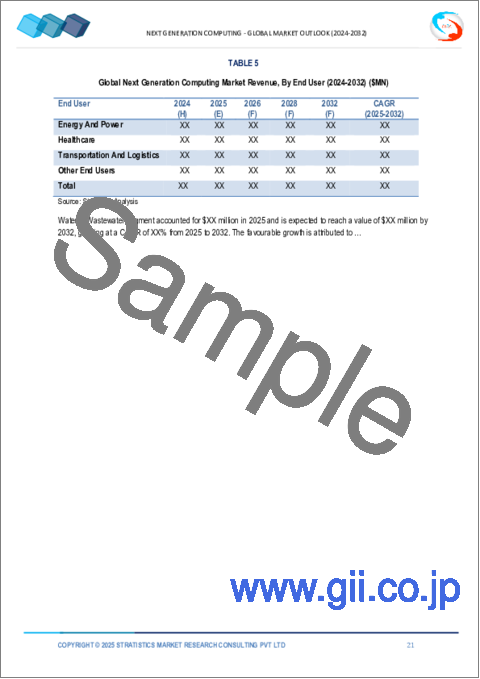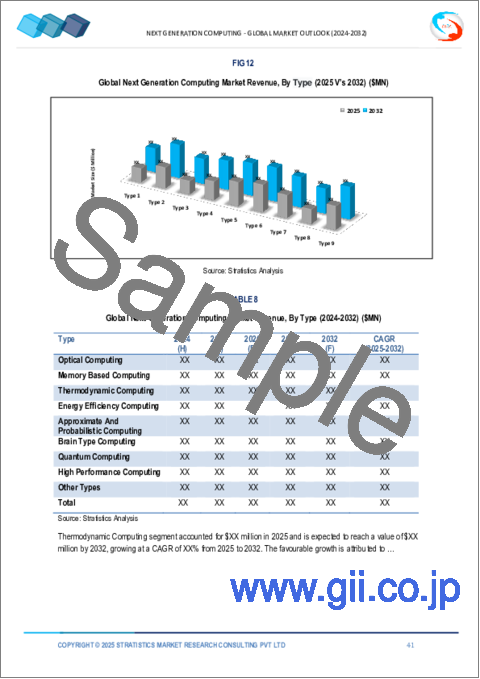|
|
市場調査レポート
商品コード
1423664
次世代コンピューティング市場の2030年までの予測: コンポーネント別、タイプ別、提供別、企業規模別、エンドユーザー別、地域別の世界分析Next Generation Computing Market Forecasts to 2030 - Global Analysis By Component (Services, Software, Hardware and Other Components), Type, Offering, Enterprise Size, End User and By Geography |
||||||
カスタマイズ可能
|
|||||||
| 次世代コンピューティング市場の2030年までの予測: コンポーネント別、タイプ別、提供別、企業規模別、エンドユーザー別、地域別の世界分析 |
|
出版日: 2024年02月02日
発行: Stratistics Market Research Consulting
ページ情報: 英文 200+ Pages
納期: 2~3営業日
|
全表示
- 概要
- 図表
- 目次
Stratistics MRCによると、世界の次世代コンピューティング市場は、2023年に2,348億米ドルを占め、予測期間中のCAGRは21.0%で成長し、2030年には8,916億米ドルに達すると予測されています。
次世代コンピューティング市場とは、現在のコンピューティング能力を凌駕し、性能、効率、革新性の向上を約束する先進技術の進化を指します。この市場には、量子コンピューティング、人工知能、エッジコンピューティング、高度なネットワーキングソリューションなどの最先端技術が含まれます。量子コンピューティングは量子力学の原理を活用して複雑な計算をかつてないスピードで実行し、人工知能は機械学習とディープラーニングのアルゴリズムを統合して機械が人間の知能を模倣できるようにします。
Flexera 2020 State of the Cloud Report」によると、クラウドへの支出が大幅に増加していることに気づいたビジネスリーダーは27%に上った。
高まるエッジコンピューティングへの依存
エッジコンピューティングは、データをソースにより近い場所で処理し、待ち時間を短縮し、リアルタイム処理能力を強化することで、従来のクラウドコンピューティングの限界に対処します。モノのインターネット(IoT)が拡大し、相互接続されたデバイスから大量のデータが生成されるようになると、効率的なデータ管理と分析にはエッジコンピューティングが不可欠になります。このパラダイムシフトは、自律走行車、スマートシティ、産業オートメーションなど、低レイテンシ応答を必要とするアプリケーションにとって極めて重要です。さらに、エッジコンピューティングはパフォーマンスを向上させるだけでなく、集中型クラウドサーバーへの大規模なデータ転送の必要性を最小限に抑え、帯域幅の使用を最適化します。
高い初期コスト
量子コンピューティング、人工知能、エッジコンピューティングなどの高度なコンピューティング技術の統合には、ハードウェアとソフトウェアの両方のインフラに多額の投資が必要です。特に、予算が限られている中小企業や組織にとっては、こうした最先端技術の取得と導入にかかる初期費用は高額になる可能性があります。さらに、こうした高度なシステムを運用・保守するための人材育成にかかる費用も、経済的課題をさらに助長しています。このような経済的負担は、多くの企業にとって次世代コンピューティングへのシームレスな移行を妨げ、これらの技術が持つ変革の可能性を活用する能力を制限しています。
量子コンピューティングの進歩
量子コンピューティングは量子力学の原理を活用し、量子ビットまたは量子ビットを利用して前例のないスピードで計算を実行し、従来のコンピュータが苦手とする複雑な問題に取り組みます。複雑な数式を解き、複雑なシステムを最適化し、分子の相互作用をシミュレートする可能性は、金融、ヘルスケア、材料科学などの産業にとって計り知れない可能性を秘めています。量子コンピュータの研究開発が進むにつれ、特定のタスクにおいて量子コンピュータが古典コンピュータの計算能力を凌駕する「量子至上主義」の実現への期待が高まっています。
標準化の欠如
量子コンピューティング、人工知能、エッジコンピューティングのような新しいテクノロジーは、普遍的に受け入れられているフレームワークやプロトコルがないことが多く、断片的なエコシステムになっています。このような標準化の欠如は、異なる技術やベンダー間の連携を複雑にし、企業が次世代コンピューティング・ソリューションを採用し、拡張することを困難にしています。また、共通の標準がないため、データの移植性やシステムの互換性にも懸念が生じ、組織が異なるコンピューティング・テクノロジーを柔軟に選択・切り替えできる環境も制限されます。
COVID-19の影響:
リモートワークやデジタルコミュニケーションへの依存度の高まりにより、分散型従業員の進化するニーズをサポートするために、クラウドコンピューティングや人工知能などの高度なコンピューティング技術への需要が加速しています。しかしその一方で、経済の不確実性とパンデミックによる予算の制約が、高コストの次世代コンピューティング・イニシアチブへの投資を減速させています。サプライチェーンの混乱と物流の課題は、ハードウェア・コンポーネントの生産と配備に影響を及ぼし、プロジェクトの遅れにつながっています。
予測期間中はソフトウェア・セグメントが最大になる見込み
ソフトウェア分野は予測期間を通じて最大の市場シェアを占めました。特に人工知能は、機械学習アルゴリズムとディープラーニングモデルがデータ分析、自動化、意思決定プロセスに不可欠となり、極めて重要な役割を果たしています。量子コンピューティングの能力を活用できる洗練されたソフトウェアの開発もこの急増に寄与しており、複雑な問題をかつてないスピードで解決できるようになっています。さらに、ソフトウェアはエッジコンピューティングの機能を最適化・管理する上で重要な役割を果たしており、ソースでのリアルタイムデータ処理と分析を可能にしています。
予測期間中、光コンピューティング・セグメントが最も高いCAGRが見込まれる
光コンピューティング分野は、従来のコンピューティングアーキテクチャに革命をもたらす可能性があるため、予測期間中のCAGRが最も高くなると予想されます。光コンピューティングは、従来の電子信号の代わりに光粒子または光子を活用して計算を実行するため、処理速度の大幅な高速化とエネルギー消費の削減が期待できます。さらに、光システム固有の並列性により、膨大なデータの同時処理が可能になり、従来のコンピュータにおける逐次処理の限界を克服します。
最大シェアの地域
アジア太平洋地域は、特に中国、日本、韓国などの国々における研究開発への旺盛な投資により、予測期間中最大の市場シェアを占めました。これらの国々は、量子コンピューティング、人工知能、ハイパフォーマンス・コンピューティングなど、新興技術のイノベーションを推進するために戦略的に資金を配分しています。特に中国は、量子コンピューティングの研究開発で大きな前進を遂げ、この変革的分野における世界的リーダーとしての地位を確立することを目指しています。
CAGRが最も高い地域:
アジア太平洋地域は、実現可能な期間にわたって収益性の高い成長を維持すると予測されています。アジア太平洋地域は、量子情報科学と量子通信ネットワークの開発に力を入れており、量子コンピューティングの展望においてアジア太平洋地域が突出している一因となっています。さらに、シンガポールや韓国のような国々における急速な都市化とスマートシティの拡大が、エッジコンピューティング、IoT、データ分析などの分野における高度なコンピューティング能力の必要性を促進しています。
無料のカスタマイズサービス:
本レポートをご購読のお客様には、以下の無料カスタマイズオプションのいずれかをご利用いただけます:
- 企業プロファイル
- 追加市場プレイヤーの包括的プロファイリング(3社まで)
- 主要企業のSWOT分析(3社まで)
- 地域セグメンテーション
- 顧客の関心に応じた主要国の市場推計・予測・CAGR(注:フィージビリティチェックによる)
- 競合ベンチマーキング
- 製品ポートフォリオ、地理的プレゼンス、戦略的提携に基づく主要企業のベンチマーキング
目次
第1章 エグゼクティブサマリー
第2章 序文
- 概要
- ステークホルダー
- 調査範囲
- 調査手法
- データマイニング
- データ分析
- データ検証
- 調査アプローチ
- 調査ソース
- 1次調査ソース
- 2次調査ソース
- 前提条件
第3章 市場動向分析
- 促進要因
- 抑制要因
- 機会
- 脅威
- エンドユーザー分析
- 新興市場
- 新型コロナウイルス感染症(COVID-19)の影響
第4章 ポーターのファイブフォース分析
- 供給企業の交渉力
- 買い手の交渉力
- 代替品の脅威
- 新規参入業者の脅威
- 競争企業間の敵対関係
第5章 世界の次世代コンピューティング市場:コンポーネント別
- サービス
- ソフトウェア
- ハードウェア
- その他のコンポーネント
第6章 世界の次世代コンピューティング市場:タイプ別
- 光コンピューティング
- メモリベースのコンピューティング
- 熱力学コンピューティング
- エネルギー効率コンピューティング
- 近似的および確率的計算
- ブレインタイプコンピューティング
- 量子コンピューティング
- ハイパフォーマンスコンピューティング
- その他のタイプ
第7章 世界の次世代コンピューティング市場:提供別
- オンプレミス
- クラウドベース
- その他の製品
第8章 世界の次世代コンピューティング市場:企業規模別
- 大企業
- 中小企業
- その他の企業規模
第9章 世界の次世代コンピューティング市場:エンドユーザー別
- エネルギーと電力
- ヘルスケア
- 輸送と物流
- その他のエンドユーザー
第10章 世界の次世代コンピューティング市場:地域別
- 北米
- 米国
- カナダ
- メキシコ
- 欧州
- ドイツ
- 英国
- イタリア
- フランス
- スペイン
- その他欧州
- アジア太平洋地域
- 日本
- 中国
- インド
- オーストラリア
- ニュージーランド
- 韓国
- その他アジア太平洋地域
- 南米
- アルゼンチン
- ブラジル
- チリ
- その他南米
- 中東とアフリカ
- サウジアラビア
- アラブ首長国連邦
- カタール
- 南アフリカ
- その他中東とアフリカ
第11章 主な発展
- 契約、パートナーシップ、コラボレーション、合弁事業
- 買収と合併
- 新製品の発売
- 事業拡大
- その他の主要戦略
第12章 企業プロファイル
- Advanced Micro Devices, Inc
- Amazon Web Services Inc.
- Cisco Systems, Inc
- Dell Inc
- Google Inc.
- Hewlett Packard Enterprise
- IBM Corporation
- Intel Corporation
- Microsoft Corporation
- NVIDIA Corporation
- Oracle Corporation
List of Tables
- Table 1 Global Next Generation Computing Market Outlook, By Region (2021-2030) ($MN)
- Table 2 Global Next Generation Computing Market Outlook, By Component (2021-2030) ($MN)
- Table 3 Global Next Generation Computing Market Outlook, By Services (2021-2030) ($MN)
- Table 4 Global Next Generation Computing Market Outlook, By Software (2021-2030) ($MN)
- Table 5 Global Next Generation Computing Market Outlook, By Hardware (2021-2030) ($MN)
- Table 6 Global Next Generation Computing Market Outlook, By Other Components (2021-2030) ($MN)
- Table 7 Global Next Generation Computing Market Outlook, By Type (2021-2030) ($MN)
- Table 8 Global Next Generation Computing Market Outlook, By Optical Computing (2021-2030) ($MN)
- Table 9 Global Next Generation Computing Market Outlook, By Memory Based Computing (2021-2030) ($MN)
- Table 10 Global Next Generation Computing Market Outlook, By Thermodynamic Computing (2021-2030) ($MN)
- Table 11 Global Next Generation Computing Market Outlook, By Energy Efficiency Computing (2021-2030) ($MN)
- Table 12 Global Next Generation Computing Market Outlook, By Approximate And Probabilistic Computing (2021-2030) ($MN)
- Table 13 Global Next Generation Computing Market Outlook, By Brain Type Computing (2021-2030) ($MN)
- Table 14 Global Next Generation Computing Market Outlook, By Quantum Computing (2021-2030) ($MN)
- Table 15 Global Next Generation Computing Market Outlook, By High Performance Computing (2021-2030) ($MN)
- Table 16 Global Next Generation Computing Market Outlook, By Other Types (2021-2030) ($MN)
- Table 17 Global Next Generation Computing Market Outlook, By Offering (2021-2030) ($MN)
- Table 18 Global Next Generation Computing Market Outlook, By On Premise (2021-2030) ($MN)
- Table 19 Global Next Generation Computing Market Outlook, By Cloud Based (2021-2030) ($MN)
- Table 20 Global Next Generation Computing Market Outlook, By Other Offerings (2021-2030) ($MN)
- Table 21 Global Next Generation Computing Market Outlook, By Enterprise Size (2021-2030) ($MN)
- Table 22 Global Next Generation Computing Market Outlook, By Large Enterprises (2021-2030) ($MN)
- Table 23 Global Next Generation Computing Market Outlook, By Small & Medium Sized Enterprise (2021-2030) ($MN)
- Table 24 Global Next Generation Computing Market Outlook, By Other Enterprise Sizes (2021-2030) ($MN)
- Table 25 Global Next Generation Computing Market Outlook, By End User (2021-2030) ($MN)
- Table 26 Global Next Generation Computing Market Outlook, By Energy And Power (2021-2030) ($MN)
- Table 27 Global Next Generation Computing Market Outlook, By Healthcare (2021-2030) ($MN)
- Table 28 Global Next Generation Computing Market Outlook, By Transportation And Logistics (2021-2030) ($MN)
- Table 29 Global Next Generation Computing Market Outlook, By Other End Users (2021-2030) ($MN)
Note: Tables for North America, Europe, APAC, South America, and Middle East & Africa Regions are also represented in the same manner as above.
According to Stratistics MRC, the Global Next Generation Computing Market is accounted for $234.8 billion in 2023 and is expected to reach $891.6 billion by 2030 growing at a CAGR of 21.0% during the forecast period. The Next Generation Computing Market refers to the evolving landscape of advanced technologies that surpass current computing capabilities, promising enhanced performance, efficiency, and innovation. This market encompasses a spectrum of cutting-edge technologies such as quantum computing, artificial intelligence, edge computing, and advanced networking solutions. Quantum computing leverages the principles of quantum mechanics to perform complex computations at unprecedented speeds, while artificial intelligence integrates machine learning and deep learning algorithms to enable machines to mimic human intelligence.
According to the Flexera 2020 State of the Cloud Report", a significant growth in cloud spending was noticed by 27% of business leaders during the outbreak.
Market Dynamics:
Driver:
Growing reliance on edge computing
Edge computing addresses the limitations of traditional cloud computing by processing data closer to the source, reducing latency and enhancing real-time processing capabilities. As the Internet of Things (IoT) expands, generating massive volumes of data from interconnected devices, edge computing becomes essential for efficient data management and analysis. This paradigm shift is crucial for applications requiring low-latency responses, such as autonomous vehicles, smart cities, and industrial automation. Moreover, edge computing not only improves performance but also minimizes the need for extensive data transfers to centralized cloud servers, optimizing bandwidth usage.
Restraint:
High initial costs
The integration of advanced computing technologies, such as quantum computing, artificial intelligence, and edge computing, requires substantial investments in both hardware and software infrastructure. The initial financial outlay for acquiring and implementing these cutting-edge technologies can be prohibitive, particularly for smaller businesses and organizations with limited budgets. Additionally, the costs associated with training personnel to operate and maintain these sophisticated systems further contribute to the economic challenges. This financial burden impedes the seamless transition to next-generation computing for many enterprises, limiting their ability to harness the transformative potential of these technologies.
Opportunity:
Advancements in quantum computing
Quantum computing leverages the principles of quantum mechanics, utilizing quantum bits or qubits to perform computations at unprecedented speeds and tackle complex problems that traditional computers struggle with. The potential to solve intricate mathematical equations, optimize complex systems, and simulate molecular interactions holds immense promise for industries such as finance, healthcare, and materials science. As research and development in quantum computing progress, there is a growing anticipation of achieving quantum supremacy, where quantum computers surpass the computational capabilities of classical computers for specific tasks.
Threat:
Lack of standardization
Emerging technologies like quantum computing, artificial intelligence, and edge computing often lack universally accepted frameworks and protocols, leading to a fragmented ecosystem. This absence of standardization complicates collaboration between different technologies and vendors, making it challenging for businesses to adopt and scale next-generation computing solutions. The lack of common standards also raises concerns regarding data portability and system compatibility, limiting the flexibility for organizations to choose and switch between different computing technologies.
Covid-19 Impact:
The increased reliance on remote work and digital communication has accelerated the demand for advanced computing technologies, such as cloud computing and artificial intelligence, to support the evolving needs of a distributed workforce. However, on the other hand, economic uncertainties and budget constraints induced by the pandemic have slowed down investments in certain high-cost next-generation computing initiatives. Supply chain disruptions and logistical challenges have affected the production and deployment of hardware components, leading to delays in projects.
The software segment is expected to be the largest during the forecast period
Software segment dominated the largest market share throughout the projected period. Artificial intelligence, in particular, is playing a pivotal role with machine learning algorithms and deep learning models becoming integral for data analysis, automation, and decision-making processes. The development of sophisticated software that can harness the capabilities of quantum computing is also contributing to this surge, enabling the solution of complex problems at unprecedented speeds. Furthermore, software plays a crucial role in optimizing and managing the functionalities of edge computing, allowing for real-time data processing and analysis at the source.
The optical computing segment is expected to have the highest CAGR during the forecast period
Optical Computing segment is expected to have the highest CAGR during the forecast period due to its potential to revolutionize traditional computing architectures. Optical computing leverages light particles or photons instead of traditional electronic signals to perform computations, offering the promise of significantly faster processing speeds and reduced energy consumption. Additionally, the inherent parallelism of optical systems enables the simultaneous handling of vast amounts of data, overcoming the limitations of sequential processing in classical computers.
Region with largest share:
Asia Pacific region commanded the largest market share over the extrapolated period due to region's robust investment in research and development, particularly in countries like China, Japan, and South Korea. These nations have strategically allocated funds to propel innovation in emerging technologies, including quantum computing, artificial intelligence, and high-performance computing. China, in particular, has made significant strides in quantum computing research and development, aiming to establish itself as a global leader in this transformative field.
Region with highest CAGR:
Asia Pacific region is projected to hold profitable growth over the feasible period. The country's commitment to quantum information science and the development of quantum communication networks has contributed to the Asia Pacific region's prominence in the quantum computing landscape. Moreover, rapid urbanization and the expansion of smart cities in countries like Singapore and South Korea are driving the need for sophisticated computing capabilities in areas such as edge computing, IoT, and data analytics.
Key players in the market
Some of the key players in Next Generation Computing market include Advanced Micro Devices, Inc, Amazon Web Services Inc., Cisco Systems, Inc, Dell Inc, Google Inc., Hewlett Packard Enterprise, IBM Corporation, Intel Corporation, Microsoft Corporation, NVIDIA Corporation and Oracle Corporation.
Key Developments:
In July 2023, Moody's and Microsoft have partnered strategically to co-create next-generation data, analytics, research, collaboration, and risk solutions for financial services, which would be built by combining Microsoft's Azure OpenAI Service, Fabric, and Teams with Moody's proprietary data, analytics, and research and has been designed to enhance insights into corporate intelligence and risk assessment.
In July 2023, Equinix, GDS, Microsoft, and a consortium of AirTrunk and TikTok-owner ByteDance were selected to operate the Singapore-based 80 MW data center by the Singapore Economic Development Board and the Infocomm Media Development Authority, which would support the adoption of next-generation computing solutions in the APAC region.
In June 2023, Google Llc partnered with T-Mobile to empower 5G and edge computing capabilities, enabling enterprises to increase their digital transformation. After this partnership, T-Mobile would connect the 5G ANS suite of public, private, and hybrid 5G networks with Google Distributed Cloud Edge (GDC Edge) to help customers have next-generation 5G applications such as AR/VR experiences.
Components Covered:
- Services
- Software
- Hardware
- Other Components
Types Covered:
- Optical Computing
- Memory Based Computing
- Thermodynamic Computing
- Energy Efficiency Computing
- Approximate And Probabilistic Computing
- Brain Type Computing
- Quantum Computing
- High Performance Computing
- Other Types
Offerings Covered:
- On Premise
- Cloud Based
- Other Offerings
Enterprise Sizes Covered:
- Large Enterprises
- Small & Medium Sized Enterprise
- Other Enterprise Sizes
End Users Covered:
- Energy And Power
- Healthcare
- Transportation And Logistics
- Other End Users
Regions Covered:
- North America
- US
- Canada
- Mexico
- Europe
- Germany
- UK
- Italy
- France
- Spain
- Rest of Europe
- Asia Pacific
- Japan
- China
- India
- Australia
- New Zealand
- South Korea
- Rest of Asia Pacific
- South America
- Argentina
- Brazil
- Chile
- Rest of South America
- Middle East & Africa
- Saudi Arabia
- UAE
- Qatar
- South Africa
- Rest of Middle East & Africa
What our report offers:
- Market share assessments for the regional and country-level segments
- Strategic recommendations for the new entrants
- Covers Market data for the years 2021, 2022, 2023, 2026, and 2030
- Market Trends (Drivers, Constraints, Opportunities, Threats, Challenges, Investment Opportunities, and recommendations)
- Strategic recommendations in key business segments based on the market estimations
- Competitive landscaping mapping the key common trends
- Company profiling with detailed strategies, financials, and recent developments
- Supply chain trends mapping the latest technological advancements
Free Customization Offerings:
All the customers of this report will be entitled to receive one of the following free customization options:
- Company Profiling
- Comprehensive profiling of additional market players (up to 3)
- SWOT Analysis of key players (up to 3)
- Regional Segmentation
- Market estimations, Forecasts and CAGR of any prominent country as per the client's interest (Note: Depends on feasibility check)
- Competitive Benchmarking
- Benchmarking of key players based on product portfolio, geographical presence, and strategic alliances
Table of Contents
1 Executive Summary
2 Preface
- 2.1 Abstract
- 2.2 Stake Holders
- 2.3 Research Scope
- 2.4 Research Methodology
- 2.4.1 Data Mining
- 2.4.2 Data Analysis
- 2.4.3 Data Validation
- 2.4.4 Research Approach
- 2.5 Research Sources
- 2.5.1 Primary Research Sources
- 2.5.2 Secondary Research Sources
- 2.5.3 Assumptions
3 Market Trend Analysis
- 3.1 Introduction
- 3.2 Drivers
- 3.3 Restraints
- 3.4 Opportunities
- 3.5 Threats
- 3.6 End User Analysis
- 3.7 Emerging Markets
- 3.8 Impact of Covid-19
4 Porters Five Force Analysis
- 4.1 Bargaining power of suppliers
- 4.2 Bargaining power of buyers
- 4.3 Threat of substitutes
- 4.4 Threat of new entrants
- 4.5 Competitive rivalry
5 Global Next Generation Computing Market, By Component
- 5.1 Introduction
- 5.2 Services
- 5.3 Software
- 5.4 Hardware
- 5.5 Other Components
6 Global Next Generation Computing Market, By Type
- 6.1 Introduction
- 6.2 Optical Computing
- 6.3 Memory Based Computing
- 6.4 Thermodynamic Computing
- 6.5 Energy Efficiency Computing
- 6.6 Approximate And Probabilistic Computing
- 6.7 Brain Type Computing
- 6.8 Quantum Computing
- 6.9 High Performance Computing
- 6.10 Other Types
7 Global Next Generation Computing Market, By Offering
- 7.1 Introduction
- 7.2 On Premise
- 7.3 Cloud Based
- 7.4 Other Offerings
8 Global Next Generation Computing Market, By Enterprise Size
- 8.1 Introduction
- 8.2 Large Enterprises
- 8.3 Small & Medium Sized Enterprise
- 8.4 Other Enterprise Sizes
9 Global Next Generation Computing Market, By End User
- 9.1 Introduction
- 9.2 Energy And Power
- 9.3 Healthcare
- 9.4 Transportation And Logistics
- 9.5 Other End Users
10 Global Next Generation Computing Market, By Geography
- 10.1 Introduction
- 10.2 North America
- 10.2.1 US
- 10.2.2 Canada
- 10.2.3 Mexico
- 10.3 Europe
- 10.3.1 Germany
- 10.3.2 UK
- 10.3.3 Italy
- 10.3.4 France
- 10.3.5 Spain
- 10.3.6 Rest of Europe
- 10.4 Asia Pacific
- 10.4.1 Japan
- 10.4.2 China
- 10.4.3 India
- 10.4.4 Australia
- 10.4.5 New Zealand
- 10.4.6 South Korea
- 10.4.7 Rest of Asia Pacific
- 10.5 South America
- 10.5.1 Argentina
- 10.5.2 Brazil
- 10.5.3 Chile
- 10.5.4 Rest of South America
- 10.6 Middle East & Africa
- 10.6.1 Saudi Arabia
- 10.6.2 UAE
- 10.6.3 Qatar
- 10.6.4 South Africa
- 10.6.5 Rest of Middle East & Africa
11 Key Developments
- 11.1 Agreements, Partnerships, Collaborations and Joint Ventures
- 11.2 Acquisitions & Mergers
- 11.3 New Product Launch
- 11.4 Expansions
- 11.5 Other Key Strategies
12 Company Profiling
- 12.1 Advanced Micro Devices, Inc
- 12.2 Amazon Web Services Inc.
- 12.3 Cisco Systems, Inc
- 12.4 Dell Inc
- 12.5 Google Inc.
- 12.6 Hewlett Packard Enterprise
- 12.7 IBM Corporation
- 12.8 Intel Corporation
- 12.9 Microsoft Corporation
- 12.10 NVIDIA Corporation
- 12.11 Oracle Corporation





